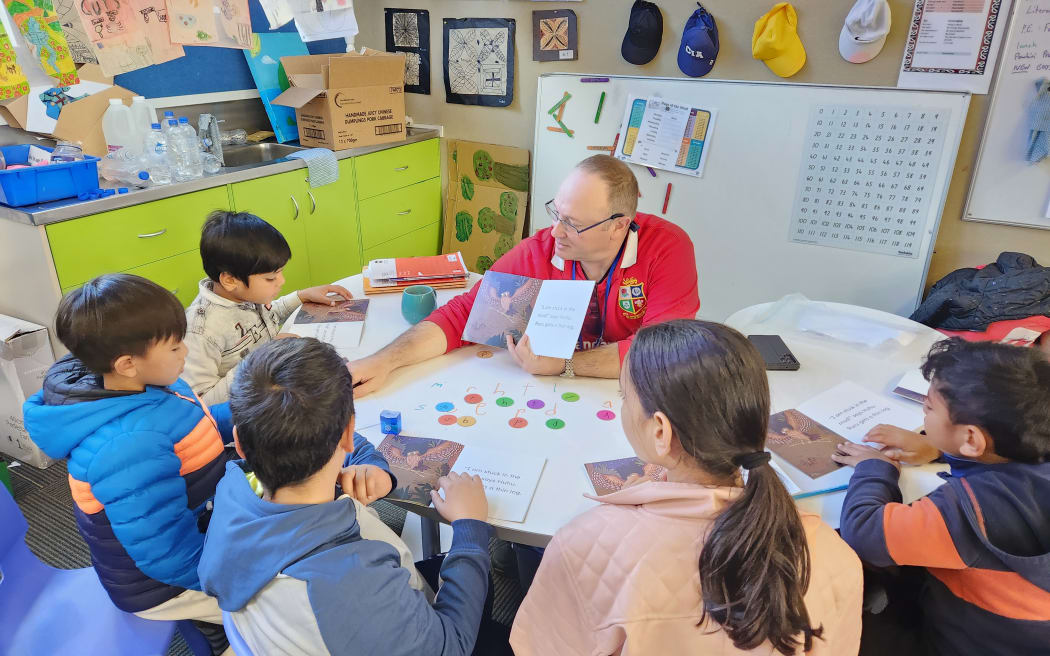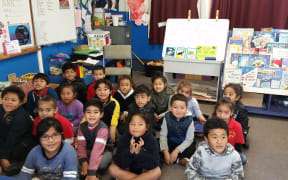
Petone Central School principal Trina Bennett. Photo: RNZ / John Gerritsen
A spike in enrolments of new migrant children has surprised some schools.
In the past financial year, Immigration New Zealand approved 16,899 study visas for the dependent children of people with work visas - a jump of about 70 percent on pre-pandemic levels when fewer than 10,000 a year were approved.
Principals told RNZ they had noticed a definite increase and it was putting pressure on English language teaching resources.
Petone Central School principal Trina Bennett said the school's roll of 140 students included about 50 new migrant students who arrived this year with little to no English.
"We've just seen so many come from Sri Lanka, Fiji, India, Vietnam, and China. We've never seen this amount of ESOL (English for Speakers of Other Languages) students come all at one time.
"Of the children we've had in, they've all had limited English to no English and it's been a bit of a challenge to meet the language barriers because you can't guarantee that Google Translate will give you all of the necessary words that you need," she said.
Bennett said the school had assigned a teacher to oversee ESOL pupils, another was in charge of assisting their English-language acquisition, and multi-lingual children helped the new arrivals fit into school.
The school received ESOL funding from the Education Ministry, she said.
"We're doing what we can with the resources that we have. I know that we're not the only school that has had an influx of ESOL students," she said.
Bennett said in a group of 15 local schools, six had experienced high enrolments by new migrants.
Ormiston Primary School principal Heath McNeil said his school's relatively new neighbourhood in east Auckland attracted a lot of new migrants but he had noticed a definite increase in the past few months.
"We probably enrolled 260 children into our school this year and out of that probably around 50, 60 would be children that have come straight basically off the plane into their new house and into their new school," he said.
He said Ormiston Primary had more than 500 pupils who attracted Education Ministry ESOL funding, more than any other school in the country, and it was well-prepared for helping new migrant children settle in and learn English.
But he worried the influx of non-English speaking pupils would be challenging for schools that were not accustomed to large numbers of new arrivals.
McNeil said migrant children often needed help understanding how the school day worked, and sometimes families had to adjust to very different expectations.
"I was meeting with a family yesterday and they were talking about their nine-year-old son would be up till 10, 11 at night in his home country doing tasks and homework just to prepare for the next day so sometimes it's about that transition into a wider more holistic view of education," he said.
Botany Downs Secondary College principal Karen Brinsden said her school also noticed a big increase in ESOL students, but from a different group - residents returning after long periods living in China or other Asian countries.
"It's just been ongoing enrolments since we've started up and it's just continuing. Every second week or so we're getting new enrolments who need that English language support due to their lengthy time abroad," she said.
"It's all the way from recognising simple basic words right through to they just need that extra support with academic language."
She said the increase was unexpected and it was putting pressure on the school's English-teaching system.
"We're giving them intense support with their ESOL so that has created some tension in that those classes [that] are now full and we're having to go outside and be quite creative with their timetables so that they can come in for English support," Brinsden said.
She said ESOL funding was helpful but quality ESOL teachers were in short supply.
"We don't have enough access to great ESOL teachers," she said.
Immigration New Zealand figures showed South Africa, India, China and the Philippines provided more than half of the students who gained study visas because their parents were migrant workers.
"The increase in visas for the dependents of workers likely reflects the high volume of Accredited Employer Work Visas that have been issued since the visa was launched with the reopening of New Zealand's borders," Immigration New Zealand said.
"More time is needed to assess whether the increase you have identified is a spike that is being driven by pent-up demand from border restrictions during the Covid-19 response, or whether this is an ongoing trend."
The Education Ministry said applications for ESOL funding increased 8 percent between school terms 3 and 4 in 2022 and school terms 1 and 2 in 2023.
'It is not easy' - ESOL teacher

Petone Central School teacher Richard Taylor working with ESOL pupils. Photo: RNZ / John Gerritsen
Petone Central School teacher Richard Taylor said his class welcomed 10 new students this year, only one of whom spoke English as a first language.
"At the start of the year in terms of ethnicity, we had quite a diverse balance of Māori, Pacific Island, Pākehā and South East Asian but that's changed significantly over the last few terms as we've had quite an influx of South-East Asian and other country immigrants. So now probably the second-most popular language in our class is Hindi," he said.
Taylor was teaching reading to a small group of ESOL pupils when RNZ visited his classroom, sounding out letters and offering frequent encouragement.
He said the change in the school's population added to its atmosphere.
But he said ensuring his teaching was pitched at the right levels for a class with such a diverse range of English was "a massive challenge".
"You don't have the luxury you have with English-language-first-speaking students where if you get something wrong you can explain it or you can model. If you pitch something wrong for a student who has very limited English, they're stuck," he said.
"I'm actually finding it very, very challenging. With time it'll get better and we'll get better at it but it is not easy."





